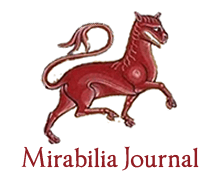Regarding about Dietari from Català de Valeriola (1568-1608)
Carles FENOLLOSA LAGUARDA
Original title: A propòsit del Dietari de Català de Valeriola (1568-1608)
Published in
Keywords: Catalan Literature, Català de Valeriola, Diaries, Memorialistic, Sixteenth century, Valencia.
This paper provides a general overview of one of the figures of sixteenth century Valencian literature, Bernat Català de Valeriola, and his lesser well-known diary, one of the best examples of the Valencian memorialistic works of that period.
Register and fabulistic tradition: the case of Wolf, the fox and the ape
Claudio R. CUELLAR
Original title: Registro y tradición fabulística: el caso del lobo, la zorra y el simio
Published in
Keywords: Collocation, Fidem, Furtum, Lexical cohesion, Systemic-functional grammar.
The objective of this communication is to analyze the purpose that is granted to the legal use of slang and knowledge of the Roman law and Spanish in two sources that tell a judicial process by theft: on the one hand, the episode on the lawsuit that happened between the wolf, the fox and Don Ximio in the Libro de Buen Amor (321-371); and on the other hand, we will analyze the roman version in which indirectly inspired the Arcipreste de Hita, the fable “Lupus et vulpes judice simio” (Pha. Ae. X) written by Fedro. And given that it is studying the log to determine the reception of Roman law and Spanish in the mentioned authors, use -the only methodological effect – the grammar systemic-functional, in regard to placement and the field, tenor and mode.
Relics, materiality and expression of the sacred body: a medieval wooden sculpture in the National Museum of Art of Buenos Aires
María Laura MONTEMURRO
Original title: Reliquias, materialidad y expresión del cuerpo sagrado: una talla medieval en el Museo Nacional de Bellas Artes de Buenos Aires
Published in
Keywords: National Museum of Art of Buenos Aires, Reliquary sculpture, Virgin and Child in Majesty.
Among the works of medieval art preserved at the National Art Museum of Buenos Aires, there is an important medieval sculpture of the Virgin and Child in Majesty. This 12th century wooden sculpture from the French region of Auvergne exemplifies a type of carving that became very popular around the second half of that century: the so-called “Throne of Wisdom” or Sedes Sapientiae. Such sculptures were generally employed as reliquaries and hold special interest for the art historian since they mark the renaissance of sculpture in the round nearly five hundred years after this technique had fallen into disuse. How can we explain then, the transition from a period of nearly complete lack of sculpture in the round to one of increasing popularity of these same carvings? In this paper we propose that the same motives argued by ecclesiastical authorities to object tridimensional sculpture, later became the reason why these Sedes Sapientiae sculptures turned to be regarded as objects of a foremost devotional value and attracted a massive popular cult. The same nature of the sculptural technique (its tridimensional character), as well as the focus on its materiality, together with the inclusion of built-in relics, resulted in the “epiphanic character” that Jean Claude Schmitt has assigned to the medieval image. We believe that the sculpture in Buenos Aires, and other similar carvings, did not only succeed in representing a sacred body but even, in a certain way, to restore it.
Religious formulae with prophylactic purposes within the Andalusi context
Alejandro RAMOS RODRÍGUEZ
Original title: Fórmulas religiosas con finalidad profiláctica en el contexto andalusí
Published in
Keywords: Epigraphy, Islam, Magic, Religion, Talisman.
This article presents a group of metal artifacts, which are usually classified as talismans. In these artifacts we can read epigraphic engraved legends that are related to Koran and other Islamic religious formula. This fact displays the close relationship existing between magic and religion as parts of a cosmology concerning the belief in a supernatural world. This relationship is avoided or denied by the Orthodox Establishment, although it is spread among Al-Andalus population.
Rembrandt, painter of the Old Testament scenes: Samson’s stories
Alejandro ELIZALDE GARCÍA
Original title: Rembrandt, pintor de escenas veterotestamentarias: historias de Sansón
Published in
Keywords: Delilah, Jews, Old Testament, Rembrandt, Republic of the Seven United Provinces of the North, Samson.
The scientific investigations carried out during the last century aimed to address the influence that Calvinism, religion emerged during the sixteenth century as a response to the corrupt ecclesiastical institution, exercised in the various areas – social, economic and artistic – of the Republic of the Seven Provinces of the North. However, Calvinism does not help to fully understand the religious scenes produced by Hamerszoon Rijn van Rembrandt. This architect, formed in an environment of freedom of worship, halfway between the Reformed Church and the Christian Church, maintained throughout his life friendship with Jews, men of great culture and great weight in society. These relationships, along with their own life experiences, modulated their sacred scenes. Especially interesting is the analysis of the canvases painted during the 1930s and focusing on the figure of Samson, hero of the Old Testament. These compositions, milestones in the career of the painter, are still wrapped in a halo of mystery, especially with respect to his commission. In addition, these allow us to know the way in which Rembrandt composed his works, using either textual or visual sources close to his space and time or completely distant to him.
Representations of the ideal city in the imaginary of the medieval Islam
Mª Florencia FERNÁNDEZ LLAMAS
Original title: Representaciones de la ciudad ideal en el imaginario del islam medieval
Published in
Keywords: Al-Fārābī, Ibn Rušd, Islamic cities, Koran.
Analysis of the concept and the place of cities in the Islamic cultural sphere, starting with the analysis of city as it’s mentioned in the Quran, as the place where humans live in a society, generally corrupt, followed by several mentions of legendary cities cited in the literature, and finishing with the mention of ideals of city elaborated by Islamic philosophers (Ibn Rušd, Al-Fārābī, etc.).
Research integrity and the impact of conflicts of interests on society: An Analysis in the Light of the Theory of Recognition of Axel Honneth
Márcia Cássia CASSIMIRO, Agemir BAVARESCO, André Marcelo M. SOARES
Original title: Integridade científica e o impacto dos conflitos de interesses na sociedade: Uma Análise à Luz da Teoria do Reconhecimento de Axel Honneth
Published in
Keywords: Axel Honneth, Conflict of interest (COI), Research integrity, Theory of Recognition.
Conflicts of interest (COI) is a set of conditions in which professional judgment concerning a primary interest tends to be unduly influenced by a secondary interest. In biomedical research, for example, secondary interests may affect research participants and bias research results. From a Honnethian perspective, struggles for recognition of COIs can be seen as a moral force driving social development with a focus on human dignity. Accordingly, Vasconcelos et al. have shown that in the last decades, the dialogue between science and society has reflected concerns over COIs and management of these conflicts in the realm of scientific publications. In this context, research supported by the pharmaceutical industry, for example, is a case in point. Although the extent to which this funding influences the behavior of researchers is not fully understood, there has been an increase in research misconduct in the last decades, and COIs play a role in many cases. As part of an ongoing doctoral project, this contribution makes a case that the training of Brazilian researchers in the health sciences and their understanding of science and society need to be revisited. We will address the process of construction of scientific knowledge and the ethical dilemmas encountered by these researchers when it comes to COIs in their professional and academic activities. Using elements of Honnethian philosophy, we aim to identify whether notions of COIs among this group arise from a mistaken understanding of public management of the research sector, resulting in social disrespect, reifying individuals in the process of participation in social control of the resources involved in research.
Royal Feuds and the Politics of Sanctity in Anglo-Saxon England and Ottonian Saxony
Laura WANGERIN
Published in Pleasure in the Middle Ages
Keywords: Anglo-Saxons, Feud, Legal History, Ottonians, Royal Saints.
This paper is an examination of sanctification and politics in Anglo-Saxon England and Ottonian Saxony. The evidence suggests that a feud culture and feuding behaviours were the reasons for the proliferation of sanctified murdered Anglo-Saxon kings in the late-eighth through mid-ninth centuries, a phenomenon unique to England in this time period. An investigation of the nature of royal feuds in England, in contrast to those in Saxony, further suggests that the sanctification and cults of these Anglo-Saxon murdered kings were a strategic part of feuding interactions and negotiations between families. It also supports arguments for the relationship between a feud culture and the proliferation of legislative activity by the Anglo-Saxons, and offers new possibilities for understanding the dearth of legislative activity by the Ottonians.
Sacred Architecture and Nature in the Cantigas de Santa María
Ricardo da COSTA, Bárbara DANTAS
Original title: A Arquitetura Sagrada e a Natureza nas Cantigas de Santa María (séc. XIII)
Published in Art, Criticism and Mysticism
Keywords: Cantigas de Santa Maria, Medieval Art, Medieval Literature, Nature.
The Middle Ages was the time of insertion of man in Natural environment. More than that: it was, mainly, the time of the conquest of space, the large land clearance, the architectural constructions (sometimes in the middle of Nature), and the expansions at the expense of the environment. The monastic movements were the drivers of this increase. In this sense, the monks were, par excellence, the pathfinders, the lords, the domesticators of Nature, both subjects as objects to induce this process of understanding, civilization. Theology itself so allowed (“For every sort of beast and bird and every living thing on earth and in the sea has been controlled by man and is under his authority”, Jas 3, 7). The Western civilization was the daughter of this process, of this relationship, of this symbiosis, often unintended, between Nature and Culture, Civilization and Barbarism, raw and cooked. The purpose of this study is to analyze the iconography of the illuminations of two songs and one praise present in the Cantigas de Santa Maria, a work attributed to Alfonso X, the Wise. Our methodology consisted of thematically define the presence of Nature in those three illuminated, so when we fix the following artistic tops: 1) The Sacred Nature (cantiga 10), 2) The Supplicant Nature (cantiga 93) and 3) The Saving Nature (cantiga 7). In order, from Nature that surrounds and adorns the Virgin to Nature, which witnesses the passage of time, in a paradoxical duality between the eternal time of Nature and the fleeting and fickle weather of Art. Meanwhile, the Nature who pleads isolates the leper in his retreat, and, ultimately, the saving Nature is one that involves with his heavenly robe who ask the intercession of the Virgin.
Saint Augustine and the definition of Music as Scientia (De Musica I, IV, 5)
Luís Carlos Silva de SOUSA
Original title: Santo Agostinho (354-430) e a definição de Música como Scientia (De Musica I, IV, 5)
Published in Music in Antiquity, Middle Ages & Renaissance
Keywords: Modulation, Music, Order, Reason, Saint Augustine, Scientia, Transcendence.
The objective of this work is to analyse the use of the term Scientia in the definition of Music proposed by Saint Augustine in the work De Musica (I, IV, 5). The Music, one of the seven Liberal Arts, was understood by Augustine as a manifestation of th order of audible realities. The Music had as its object not exactly modulatio, but bona modulatio. Many animals are capable of modulation, they fellow numerical laws: but, for Saint Augustine, the Music was a Scientia bene modulandi, and it assumed a specific, transcendent telos (τέλος). The term Scientia could not be dispensed with, since ignorance of the bona modulatio, as an exercise of Reason, could cause disorder in the use of song.






















































































